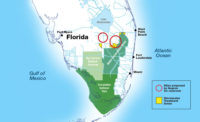Rehabilitation of the Herbert Hoover Dike surrounding Lake Okeechobee in Florida’s Everglades will be expedited by $50 million of state funds under an April 17 agreement between the state and the U.S. Army Corps of Engineers. The Corps will use it to fund a $55 million construction contract awarded Feb. 28, contingent on funding in future years, to Treviicos South to construct six miles of partial cutoff wall on the southern end of Lake Okeechobee west of Belle Glade. “That $50 million allows us to fully fund and fully commit to the contract,” says John Campbell, spokesman.
This contract is part of a $1.8 billion rehabilitation program designed to reduce flood risk for people living and working around the lake. Since 2001, USACE has invested more than $940 million to construct several features that include installation of 21 miles of seepage barrier and replacement of close to two dozen water control structures. The seepage barrier or cutoff wall consists of cement bentonite slurry poured into the body of the earthen dike to prevent seepage under the structure that could erode it and cause it to fail.
In the 2017 legislative session, Gov. Rick Scott (R) sought $200 million for the dike’s rehabilitation, but secured only $50 million. This year, the legislature appropriated an additional $50 million, bringing the total to an unprecedented $100 million state commitment for dike rehabilitation.
Remaining work will cost $800 million. To date, of the 32 culverts in the dike, eight have been replaced, one removed and 18 are under contract in various stages of construction. Two more are yet to be replaced and three near the town of Okeechobee will be abandoned, says Campbell.
Cutoff wall installation is on a separate track. Of 35 miles of cutoff wall, work on six has just been awarded, leaving 29 miles more. USACE estimates completion of work on the entire 143-mile structure in 2025, but Scott is pressing for completion by 2022. To make that schedule, $400 million per year would be required starting in 2019. In the last 10 years, the work has cost on average $80 million per year, Campbell says. “That obviously would be a substantial increase in funding that we would need to accelerate completion by 2022.” For now, USACE’s official completion date remains 2025.


